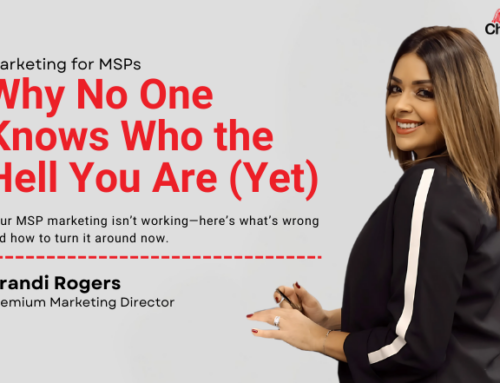The MSP market is always changing. Our business model is still very new, so it’s not surprising that, the more the market grows, the more we have to change. With MSPs popping up everywhere, the competition is fierce, prospects have many more options, and the ability to close a deal is much tougher.
The term “Sales Enablement” might be a shiny new object that Sales Managers are reaching for, but, if you look deep enough you’ll find that it is more than just a buzzword. Today’s buyers want to talk with salespeople who bring value and insight to them, and who can help them make informed decisions.
There’s an old business axiom that goes: adapt or die. For Sales, this usually meant that you just needed to try harder. Maybe take a new Sales Training course, or learn new ways to close. And for Marketing, it meant to try new and creative ways to gain attention. When you work as a team toward enabling the sales process with great marketing content, utilizing technology to help you connect with prospects, and uncover data about your prospects, you’ll become more focused and prepared to confront all challenges.
Sales Enablement happens when Sales & Marketing are in alignment with the same goals: Generate leads, identify HOT Leads, engage the customer early, show them the value you can bring to their business, and make the process as easy as possible for them. Sales Enablement also has a strong presence on Social Media. Sites like LinkedIn, Facebook and Instagram are valuable tools that help you reach the market you’re trying to sell to. If you Tweet a lot, Twitter can be a good tool, as can YouTube if you are able to create videos.
Sales Enablement is a collaborative process between all departments. Marketing can help by using advanced analytics to target prospects. Using automated programs to send emails and post blogs also adds value to campaigns. Any tool that provides an opportunity for the sales staff to contact new prospects will bring value to your business.
But more than just Sales and Marketing working together, your entire company needs to shift their actions into supporting Sales. Sales Enablement should become a strategic process that is part of your company’s culture, yet is transparent to your prospects. All departments will play a part in influencing situations where sales can have conversations with the right people at the right time.
That makes a lot of sense, but we all know it’s not that easy. Here are a few tips that can help you create the opportunity to talk with the right people:
Create Value:
When you’re performing your presentation in front of the decision-makers you’re trying to sell your services to, often, their decision to go with you or someone else doesn’t come down to cost. No, it comes down to the perceived VALUE they will be getting for that cost. That’s why contracts don’t always go to the cheapest price. Use Marketing to brand and promote your company as an Industry Leader. Use your Discovery to find as many weak spots in the prospect’s business as you can. And finally, use your Presentation to showcase your findings and explain why only you can offer the very best solution. As a Sales Professional, you need to be both competent and confident every time you engage with prospects.
Research:
Researching your prospects and their needs has always been important, but it’s even more so today. The challenge we are facing is that now, the prospects are researching us! Up to 70% of buyers research our industry before they are ready to talk with us. This is another area where LinkedIn and Facebook can be used. Dig deep and find both business and personal data about your prospects. Use this information to help you get a foot in the door. Find something you have in common with a key decision-maker. Anything might help, and you’ll need all the extra help you can get knowing that 59% of buyers do not want to talk with salespeople at all.
Ask For Referrals:
It’s amazing that so few salespeople ask their existing clients for referrals. One study showed that prospects are four times more likely to buy from you when you are referred to them. And 92% of prospects trust referrals from known businesses. Not enough to sway you? Here are a few more stats:
- 65 % of a company’s business comes from existing customers.
- Referral leads convert 30% better than leads generated from other marketing channels.
- Companies with formalized referral programs experience 86% more revenue growth over companies that do not.
Be Open To Change:
Build a bridge between sales and marketing. Marketing needs to hear feedback from sales about any new trends, needs, or concerns they’re hearing from clients and prospects. Sales need to hear what marketing learns from analytics, metrics, and behaviors, like email open rates. Keep your communication channels open and be willing to learn from others.
If you achieve these goals and bring Sales and Marketing into alignment as a team, sales will have more opportunities and be better prepared to speak with today’s informed buyers. Let’s do our best to become Sales Enablers.








Leave A Comment